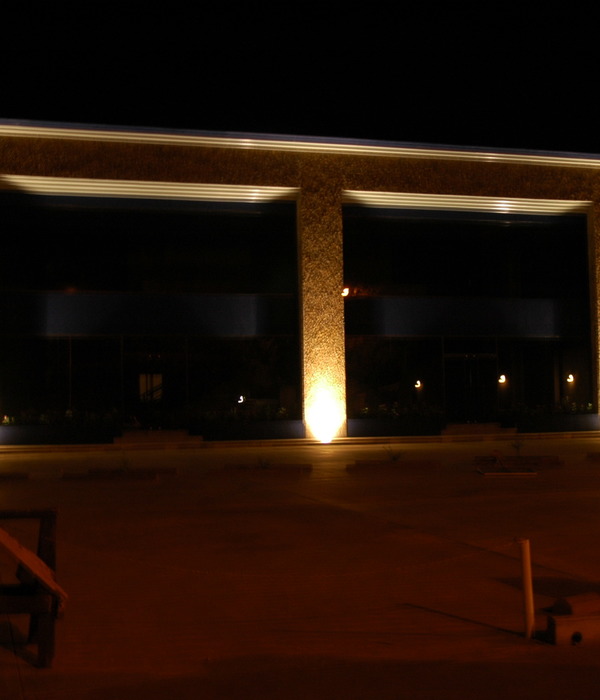Mexico habitable forest landscape
位置:墨西哥
分类:园林小品
内容:实景照片
图片:10张
kengo kuma为2014年墨西哥开放设计竞赛设计了一个名为“可居住森林”的临时建筑物。11月12号到16号,这个结构一直被安放在墨西哥城历史中心的拉丁美洲塔后面。这个临时建筑物是kengo kuma和其团队建筑方法的代表性作品,与本年度开放的主题相对应。以下是designboom对kengo kuma的采访。
designboom(以下简称DB):在设计这个临时建筑物前,墨西哥开放设计竞赛对你们的要求是什么?
kengo kuma(以下简称KK):他们让我们建造一个能突出我们思考方式和思考过程的临时建筑物。建筑的基本设计理念是要突出小规模建筑。最近我们设计了各种规模的建筑,从小小的空间到摩天大楼。但在设计每个项目时,我们都在考虑将其设计得越小越好。“小”的概念指的不是建筑的体量,尽管有些建筑规模巨大,我们仍然想在其内部创造某种“小”的感觉。这样的概念也是我们在设计这个临时建筑时探索和考虑的东西。用于建造这个结构的板块很小(90cm×90cm),你可以轻易地拿起一块嵌板。这些嵌板虽然很薄很轻,但却坚固无比。这些嵌板使得我们建造出来的临时建筑很有亲密感,这种感觉对我们工作室的设计来说十分重要。
DB:你们是怎么实现这样的设计的?
KK:我们最先考虑到的是这些板块。与混凝土等硬材料不同,它们应该是让人感觉很舒服的。当你在处理一些你自己能拿起的材料或者组件时,改装它们会让你对一个结构感觉更加平静。这种材料是亲民的,因此这个临时建筑代表着21世纪建筑的亲民性。
DB:这个临时建筑将建于墨西哥,这是否在某方面影响你们的设计?
KK:是的,我喜欢墨西哥文化中的自由。我在设计这个临时建筑时想表达的就是墨西哥文化中的自由。
DB:你最满意此设计中的哪些方面?
KK:设计中的“拥挤感”。我喜欢这种模糊的建筑形式,这些堆积层让建筑看起来不死板。通常建筑师都想要设计出某种特定的建筑造型,特别是在设计这种临时建筑的时候。但我却想要刻意避免这种设计方法。这种“拥挤”的设计使得形状很漂亮,呈流线型。我还很满意在设计时没有受到太多的限制。
DB:从这个项目中你们是否学到了一些东西以便在下次设计时使用?
KK:通过这个临时建筑的设计过程,我们更加了解了“小”的概念以及生活空间中亲民的概念。我很愿意将从这个项目中学到的东西利用到其他设计中。
译者: 柒柒
kengo kuma has designed a pavilion titled ‘bosque habitable’ (habitable forest) for the abierto mexicano de diseño 2014. the structure was installed in a public space behind the torre latino americano in the historic center of mexico city from november 12-16. the pavilion is a representation of kengo kuma and associates’ architectural approach – to tie in with the theme of this year’s abierto ‘processes’. designboom spoke to kengo kuma to learn more about the project…
designboom: what brief were you given by the abierto mexicano de diseño for this pavilion?
kengo kuma: the abierto mexicano de diseño asked us to create a pavilion that highlighted our process and way of thinking. the basis of the pavilion is to highlight small architecture – recently we’ve worked on architecture of all scales from small spaces up to towers – but in every project we try to achieve ‘smallness’. smallness is not related to the total volume of the building, even if the building itself is huge, we want to achieve the feeling of smallness within it – that’s what we have tried to explore and communicate with this pavilion. the boards used to create this structure are small (90cm by 60cm) human scale – you can easily handle one panel yourself, they are also quite thin (2cm) and light but also sturdy. so, the panels allowed us to create an intimate space – intimacy is something very important for our studio.
DB: how did you come to arrive at this solution?
KK: the starting point was the boards, we noticed that they feel very comfortable – opposed to a very heavy material like concrete, which can intimidate you. when you are dealing with a material or components that you can carry, and reconfigure it helps you feel calmer about a structure. this material is democratic, so the pavilion represents democracy and architecture in the 21st century.
DB: did the fact that the pavilion would be built in mexico influence your design in any way?
KK: yes, I love the freedom of mexican culture. I especially like the home of frida khalo and diego rivera, which I visited on my last trip to mexico city – I love the freedom of that space and the intimacy of it – those were things I wanted to represent in this pavilion. in a way this is sort of homage to that house.
DB: which aspects of the design are you most satisfied with?
KK: the ‘crowd-like’ nature of the design. I like the ambiguous form, the layers and the fact it doesn’t look rigid. usually architects try to achieve a specific form or shape, especially with pavilions but I wanted to avoid that approach. the ‘crowding’ approach resulted in a nice, fluid form. the chance to experiment without too many restrictions was also very satisfying.
DB: have you learned anything from this project that you’ll take into your next works?
KK: through the design process of this pavilion we learned more about ‘smallness’ and intimacy in living spaces. I’m very keen to apply what we started to learn in this project to different contexts.
墨西哥可居住森林景观外部实景图
墨西哥可居住森林景观外部局部实景图
墨西哥可居住森林景观外部细节实景图
墨西哥居住森林景观外部细节实景图
{{item.text_origin}}












